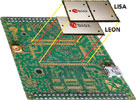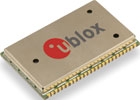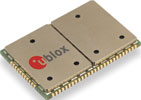

The combination of mobile communications with global positioning, Internet and multimedia services has become an accelerating industry trend, particularly for mobile resource management systems, automotive navigation and handheld consumer products.
The result is attractive new location-based applications and services that were previously impossible with either technology alone: smart, self-upgrading navigators, sophisticated vehicle and personal trackers, smartphones and tablet PCs with rich multimedia and communications capabilities.
Different market requirements require more than simply connecting a wireless modem to a positioning device. Capitalising on the combined business of in-house wireless and positioning technologies, u-blox has positioned itself to provide advanced solutions in different market segments.
One platform, one layout
World mobile communication usage has settled primarily on three network protocols: 2nd generation (2G) technologies include GSM/GPRS and CDMA2000 1xRTT; while for the 3rd generation, WCDMA and CDMA EV-DO predominate. The upcoming 4th generation, LTE, is in development and already in test in some regions around the globe.
Often a geographic region will support multiple standards provided by different carriers. For equipment manufacturers it is thus advantageous to be able to introduce a single hardware platform that can quickly adapt to different protocols simply by interchanging the modem module and upgrading the firmware. This is the case for u-blox’ LEON and LISA modem series: a single PCB footprint can be designed that adapts to 2G, 3G and 4G networks to maintain compatibility across different regional requirements.


u-blox maintains a consistent form factor approach in its wireless portfolio as well as in its GNSS portfolio to ensure that successive generations of SMT components retain layout compatibility with previous generations, allowing equipment manufacturers to easily upgrade their designs with minimal hardware and PCB changes.
Additionally, firmware compatibility between successive generations assures that designers do not lose software development time with each successive product generation.
Compact package
Pocket-sized or covertly mounted boxes have become the standard for location-aware devices. The devices typically require a microprocessor, memory, display driver, wireless modem, GPS receiver, antennas and passives, all packed into a sleek, palm-sized housing. As a modem is generally one of the largest components in the system, the smallest possible SMT package with minimum height is important.
With the LISA form factor, u-blox has one of the industry’s smallest 3G modem modules, suitable for automatic pick-and-place assembly, easy soldering, repair and visual quality control, as well as single-layer interconnect. Its leadless chip carrier (LCC) offers high reliability and robustness and allows for reliable automated pick-and-place assembly and simple visual inspection (ie, no X-ray inspection) thus significantly reducing rework and manufacturing cost.
In-band modem capability
The latest generation of automatic emergency call systems that are activated by vehicle collision require that GPS data be transmitted over the mobile voice channel, and not GPRS/HSPA or SMS due to their lower prioritisation by most 2G and 3G mobile networks. This introduces the requirement for data transmission over the voice channel which always has the highest service priority.
This capability is referred to as ‘in-band modem’ and needs to be physically supported by the wireless modem to handle emergency call devices such as those needed for Europe’s eCall and Russia’s ERA-GLONASS systems. Both the LEON and LISA module series support e-Call verified in-band modem capability.
Hybrid positioning and jamming detection
GPS satellite reception does not work everywhere. Especially when in buildings, tunnels, etc, GPS satellite signal reception can be very poor, hence making it practically impossible to determine a position. In other applications, a position sometimes would be desirable, even a coarse one, although no GPS receiver is available in the application. To address this, u-blox has developed a cellular positioning technology which utilises cellular base station information to determine an approximate position.
u-blox’ proprietary CellLocate technology, embedded into both the LEON and LISA modem families, capitalises on the ability of cellular signals to penetrate buildings and shielded containers, as well as the unique combination of wireless cell coverage associated with any given location. Moreover, the technology is independent of any network provider and can be optimised for specific customer’s regional use.
CellLocate, together with u-blox’ online assisted-GPS service (AssistNow) provides a set of powerful proprietary, free-of-charge services to provide more robust positioning, eg, in the case of GPS jamming: a GPS receiver is easily thwarted via inexpensive jammers. Integrated GPS jamming detection in the u-blox GPS receiver, together with CellLocate, can help to prevent theft before it begins. The detection of a GPS jamming signal by the GPS receiver can put a system into an alarm condition, while sending out an alert signal via the u-blox modem.
In general, the fall-back solution for GPS positioning through CellLocate offers advantages for applications where a reliable position determines safety of life, revenue stream (road-pricing/tolling) or reliable vehicle or asset tracking (stolen cars, containers). Moreover, both services are free of charge.
For more information contact Andrew Hutton, RF Design, +27 (0)21 555 8400, [email protected], www.rfdesign.co.za
| Tel: | +27 21 555 8400 |
| Email: | [email protected] |
| www: | www.rfdesign.co.za |
| Articles: | More information and articles about RF Design |

© Technews Publishing (Pty) Ltd | All Rights Reserved